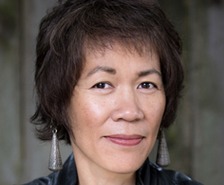Patty Enrado G'90
 From A Village in the Fields
From A Village in the Fields
“The farm workers wore scarves or bandanas, or wrapped and pinned T-shirts around their noses and mouths to keep from breathing dust. Some duct-taped the ends of their gloves to their straw hats or baseball caps. But it was useless. Late afternoons, when Fausto peeled away layers of clothes, dust clung to everything. It seeped through his outer clothes and dirtied his undershirt. Dust and sweat turned his white socks muddy brown. Even his teeth felt gritty.”
A family's story
In September 2015, at the Filipino Community Hall in Delano, California, Patty Enrado read an excerpt from A Village in the Fields (Eastwind Books of Berkeley, 2015), her historical novel depicting the lives of Filipino American farm workers. The local chapter of the Filipino American Historical Society was hosting a celebration of the 50th anniversary of the Delano Grape Strike, an event most closely associated with Cesar Chavez and the United Farm Workers union (UFW). “Few people know, however, that Filipino American farm workers initiated the strike for fair wages and better working conditions, and made important contributions to California’s farm labor movement,” says Enrado, a graduate of Syracuse University’s Creative Writing Program who grew up in a Filipino American community in Terra Bella, California. “It took 17 years to research and write my debut novel, to bring their story—my relatives’ story—to light by way of my elderly protagonist, Fausto Empleo, who looks back on his long and costly struggle for civil rights.”
Enrado spoke with Syracuse University Magazine associate editor Amy Speach about the book, which was shortlisted for the 2016 William Saroyan International Prize for Writing by the Stanford University Libraries.
A Village in the Fields book cover—how did the idea originate?
When I came back to the Bay Area after graduating from Syracuse, I went to a reading of Filipino American writers, where a poet was talking about Agbayani Retirement Village [a retirement complex for Filipino farm workers, where the book begins] and Delano and the grape strike. And I thought, “I didn’t know about this. I should explore this.” Then in ’97 there was a PBS documentary and book called The Fight in the Fields: Cesar Chavez and the Farmworkers Movement. Only one Filipino was interviewed for the film, and I remembered feeling: “Wait. There’s a bigger story here.”
Please share about how the book evolved.
In the beginning it was personal—just wanting to find that story for myself. But then it became a matter of wanting to honor my parents and my community. I did a lot of research—talking to my relatives, doing interviews, and poring over Delano Record newspaper articles. I was accumulating all this information and at some point I realized I was working on a book.
I had a full-time job throughout, writing for a media company. I have two kids who are teenagers now, and my husband and I were very active in our school district. It was hard, but I knew it had to be done.
How does it feel to have the story out there?
My goal was to get it into the Filipino American community and into students’ hands in Asian American studies classes, and that’s happening. To have the community embrace it—to have Filipinos come up to me and say, “I never knew this about our history and I’m proud of our contributions”—has been unbelievably gratifying.
How did your time at SU contribute to your work on the book?
I was blessed with meeting amazing writers—some of whom I’m still close to. Having a community who knows you and has your best interests at heart is a gift. I became a better writer through them.
